THANK YOU!
YOUR PURCHASE OF THESE BOOKS SUPPORTS THE WEB SITES THAT BRING TO YOU THE HISTORY BEHIND OLD AIRFIELD REGISTERS
Your copy of the Davis-Monthan Airfield Register 1925-1936 with all the pilots' signatures and helpful cross-references to pilots and their aircraft is available at the link. 375 pages with black & white photographs and extensive tables
---o0o---
The Congress of Ghosts (available as eBook) is an anniversary celebration for 2010. It is an historical biography, that celebrates the 5th year online of www.dmairfield.org and the 10th year of effort on the project dedicated to analyze and exhibit the history embodied in the Register of the Davis-Monthan Airfield, Tucson, AZ. This book includes over thirty people, aircraft and events that swirled through Tucson between 1925 and 1936. It includes across 277 pages previously unpublished photographs and texts, and facsimiles of personal letters, diaries and military orders. Order your copy at the link.
---o0o---
Military Aircraft of the Davis Monthan Register 1925-1936 is available at the link. This book describes and illustrates with black & white photographs the majority of military aircraft that landed at the Davis-Monthan Airfield between 1925 and 1936. The book includes biographies of some of the pilots who flew the aircraft to Tucson as well as extensive listings of all the pilots and airplanes. Use this FORM to order a copy signed by the author, while supplies last.
---o0o---
Art Goebel's Own Story by Art Goebel (edited by G.W. Hyatt) is written in language that expands for us his life as a Golden Age aviation entrepreneur, who used his aviation exploits to build a business around his passion. Available as a free download at the link.
---o0o---
Winners' Viewpoints: The Great 1927 Trans-Pacific Dole Race (available as eBook) is available at the link. This book describes and illustrates with black & white photographs the majority of military aircraft that landed at the Davis-Monthan Airfield between 1925 and 1936. The book includes biographies of some of the pilots who flew the aircraft to Tucson as well as extensive listings of all the pilots and airplanes. Use this FORM to order a copy signed by the author, while supplies last.
---o0o---
Clover Field: The first Century of Aviation in the Golden State (available in paperback) With the 100th anniversary in 2017 of the use of Clover Field as a place to land aircraft in Santa Monica, this book celebrates that use by exploring some of the people and aircraft that made the airport great. 281 pages, black & white photographs.
---o0o---
YOU CAN HELP
I'm looking for information and photographs of pilot Haizlip and her airplane to include on this page. If you have some you'd like to share, please click this FORM to contact me.
---o0o---
SPONSORED LINKS
HELP KEEP THESE WEB SITES ONLINE
FOR YOUR CONVENIENCE
You may NOW donate via PAYPAL by clicking the "Donate" icon below and using your credit card. You may use your card or your PAYPAL account. You are not required to have a PAYPAL account to donate.
When your donation clears the PAYPAL system, a certified receipt from Delta Mike Airfield, Inc. will be emailed to you for your tax purposes.
---o0o---
MAY TALMAGE HAIZLIP
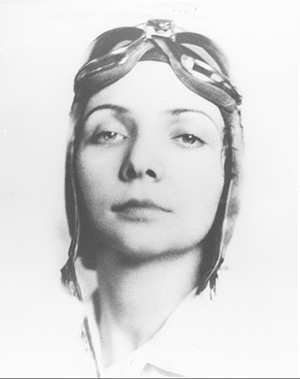 |
May Haizlip (nee: Hays) was born in the District of Columbia May 13, 1904. Her father was Charles W. Hays (b. ca. 1850; d. 1927) and her mother was Anna B. Jackson (b. ca. 1865; d. 1927). The 1910 U.S. Census, her first, places her at age 7, living with her mother and father at 162 Maple Street in St. Louis, MO with sister Vera N. (21). Her father was a mining operator (probably coal). Portrait, left, courtesy of the San Diego Aerospace Museum (SDAM).
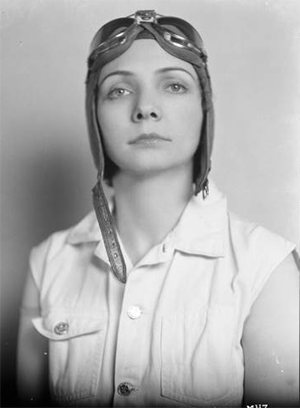 |
Haizlip moved with her father and mother to Cripple Creek, CO, 115 East Eaton Avenue, according the 1920 Census. Vera was no longer living with the family, and their father was now a "Miner" in a "Gold Mine." May was age 17 and single (see below). Another photograph, right, perhaps taken during the same sitting, is courtesy of the State Historical Society of Missouri.
Haizlip learned to fly in about 1925 as a student at the University of Oklahoma. She held a Transport license. For a short while she was a test pilot for the Spartan Aircraft Company in Tulsa, OK.
The 1930 Census placed her at age 24 living as a guest in a rooming house on Waterman Avenue in St. Louis, MO. With her were her husband, James Guy Haizlip (age 34; 1896-1983) and son, Hays T. (8; 1921-1972). May was identified as an "Aviatrix" for an "Airoplane" [sic], and James as an "Aviator" for an "Airoplane." James was identified as a veteran of WWI.
"Age at First Marriage" was a Census item in 1930. Curiously James' age at marriage was written as 32 and May's as 15 (but see the 1920 Census, above). Somewhere the arithmetic is wrong, for one or more reasons.
Although she was not mentioned in the article, an interesting finding related to 1930 is the paragraph below, from the Curtiss-Wright Corporation "Women's Department." It summarizes the numbers of pilot certificates held by women to-date. The source is the Ninety-Nines Web site at the link. Haizlip and her sister pilots were relatively rare in the realm of powered flight, with only 204 women acquiring certificates of the types indicated. Just two years earlier, when the 99s were formed as the original and premier international womens' pilot organization, there were only 99 active female pilots who joined, thus giving the association its name. Note that Register pilot Margery Doig is cited in the article.
 |
May Haizlip was active and successful with her flying accomplishments during the late 1920s and 1930s. She raced, set records, suffered the normal accidents, was a test pilot for Spartan, American Eagle, and Buhl Aircraft, taught and participated in many events for pilots and aspiring pilots around the country. Later, she was also the first woman pilot inducted into the Oklahoma Aviation and Space Hall of Fame. When she was inducted, the following quote from a news article appeared in The Oklahoman, December 17, 1982.
Mrs. Haizlip is the first woman aviator named to the hall of fame. In 10 days at the 1931 Cleveland National Air Races, she successfully flew six high-performance airplanes despite the fact that she was unfamiliar with them. In 1932 she established a women's world speed record that held for seven years. She learned to fly in Oklahoma and was the second woman in the United States to receive a commercial pilot's license. She was a test pilot for Spartan Aircraft Co., the American Eagle Co. and Buhl Aircraft Co. She now owns a real estate company in Pacific Palisades and Malibu, Calif. |
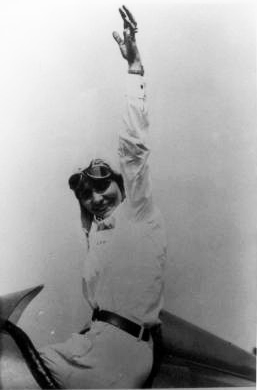 |
She competed in the 1929 National Air Races in Cleveland, OH, the first NAR that allowed women to compete in the Women's Transcontinental Air Derby from Santa Monica,CA to Cleveland, OH. She is shown in 1929, left, sitting in the cockpit of an American Eagle airplane (probably NC506H, not a Register airplane), courtesy of the International Women's Air & Space Museum. This is the one she flew in the NAR. But, her airplane was damaged and she started her race a day late. She also got lost and landed across the border in Mexicali. She was also forced down twice by a clogged oil line. She did finally make it to Cleveland, but well out of the money. According to this REFERENCE, she entered no other events that year. But she learned a lot.
 |
Besides herself, of the other 19 women who entered the 1929 NAR, 18 of them are signers of one or more of our eight airfield Registers. Interestingly, son Hays was photographed with her after the 1929 NAR just after the unique experience of flying with his mother, right, from the Breckinridge American (TX), September 5, 1929. Various articles in The New York Times and other newspapers tracked the racers' progress across the country to Cleveland.
Right after the NAR, she entered the National Air Tour, which followed a route that circumnavigated the eastern states from October 5-21, 1929. She flew her American Eagle, NC506H, a model A-129. She placed a respectable 23rd. Fellow Register pilot Jessie Keith-Miller placed 8th. Keith-Miller's performance in the Tour earned her distinction, and the manufacturer of her airplane, Fairchild, doubled her prize money to $1,000. In additon, oil and gasoline companies showered bonuses on her and the money poured in. Such was the lot of winning female pilots of the era.
A photograph of May Haizlip taken during the 1929 Air Tour is below. She wears a leather jacket and gloves and carries a folder full of papers, probably Tour rules, charts and route information, and a hat.
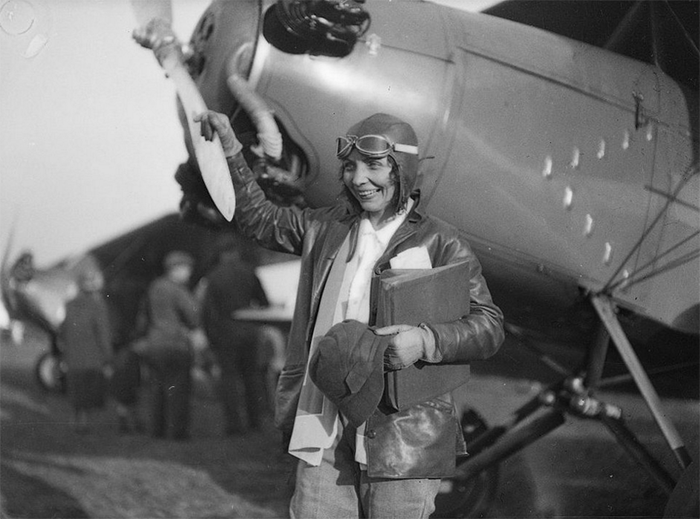 |
 |
Mrs. Haizlip, Aviatrix, Hurt In S. Carolina Greenwood, S. C.--(AP)--Mrs. May Haizlip, of St. Louis, noted woman flier, cracked up her plane in an attempted landing eight miles east of here today and was injured seriously. She was brought to a hospital here unconscious. Physicians said they were unable to make a complete examination because of her condition and could not determine the extent of her injuries. She was still unconscious four hours after the crash. |
One accident was documented in the Sheboygan Press, Sheboygan, WI, August 20, 1930, left. The New York Times of the same date reported that she was on her way from Atlanta, GA to Washington, DC in order to compete in the Dixie Derby. She apparently lost her way and attempted to land in a cotton field. Her airplane turned over, she was injured and did not regain consciousness until several hours after she reached the hospital.
Her injuries didn't prevent her from competing in the 1930 NAR. The New York TImes of August 29th reported, "Mrs. May Haizlip of St. Louis, who has just recovered from injuries suffered in a crash while participationg in the Dixie Derby, won easily in her Warner-powered Inland Sport with 121.8 miles an hour." She earned $500 for her effort.
On June 13, 1931 she broke the women's altitude record by flying a Buhl Bull Pup to 18,097 feet over St. Clair, Mi. Some news accounts reported 22,000 feet.
The 1931 NAR was a different story from 1929 or 30. She competed in the 1931 NAR in which she placed second in the Women's Transcontinental Air Derby, again from Santa Monica to Cleveland. She flew a Monocoupe and placed second to Register pilot Phoebe Omlie.
Also in 1931, she placed either first or second in six additional women's events, flying five different airplanes. And at right, she broke the women's speed record at the National Air Races in September.
She had a very successful 1931 NAR, winning $5,300 for her efforts, including $1,800 for her second-place in the Transcontinental Derby. That amount of money was much more than many citizens earned for the whole year, especially as the Great Depression deepened.
According to the AIrcraft Yearbook, at the 1932 NAR, May set a new world speed record for women in the Wedell Williams 92 Racer. On September 5th, she flew it to 252.226MPH at Cleveland. Earlier, on August 29th, her husband Jimmie had won the Bendix cross-country race from Los Angeles, CA to Floyd Bennett Field, Long Island, NY in the same airplane in 10 hours and 19 minutes, establishing a new trans-continental record and pocketing $6,750. Later that year, at the Roosevelt Hotel in New Orleans, LA, at a dinner on October 4th, she was awarded the Shell Speed Trophy for the fastest woman flyer. Her record stood until it was broken by in August, 1934 by French aviator Helene Boucher (266MPH). Jackie Cochran (not a Register pilot) broke both their records in September, 1937 (293.05MPH flying a Seversky military pursuit demonstrator with 1,200HP).
In 1933, at the NAR, she piloted a Wedell Williams Racer (#92) again. May won the Cleveland Pneumatic Tool Company Aerol Trophy Race for Woman. She pocketed $1,350 for her finish in 17:50:04 at 168.216MPH.
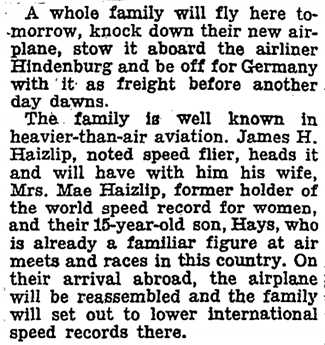 |
During the late 1930s the Haizlips enjoyed significant international travel. May Haizlip traveled solo from Southampton, England on the S.S. Washinton arriving in New York City on January 8, 1936.
Uniquely, the Haizlip family was among the passenger list for the eastward flight of the airship Hindenberg. The list appeared in The New York Times, May 21, 1936. A day earlier, the Times of May 20th announced the westbound delay of the airship off Delaware due to unfavorable winds.
The May 20th article also included the statement, left, regarding the Haizlip family. They flew an airplane to New Jersey, where the Hindenberg was to arrive, and had it disassembled to be loaded on the airship.
Another Times article on the 21st reported the arrival of the airship early that morning at Lakehurst, NJ in gusty winds. It documented the mooring, refueling, re-gassing with hydrogen, and loading of 51 passengers and freight, including the Haizlip's airplane. After that quick turnaround, the Hindenberg then departed late in the evening for the westbound journey to Frankfurt.
To my knowledge, May Haizlip is the only Register pilot to fly aboard the Hindenberg. If you are aware of others, please let me KNOW. What an interesting voyage it must have been for young Hays at age 15. I could find no information regarding their return voyage, or whether it was aboard the Hindenberg.
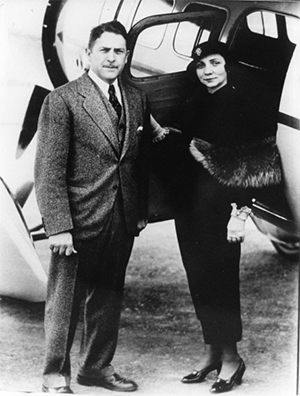 |
On another venture, the Haizlip family sailed from Havre, France aboard the S.S. City of Norfolk arriving at Baltimore, MD February 17, 1938. Hays was now 16 years old. Contemporary photograph, left, courtesy of SDAM Flickr stream.
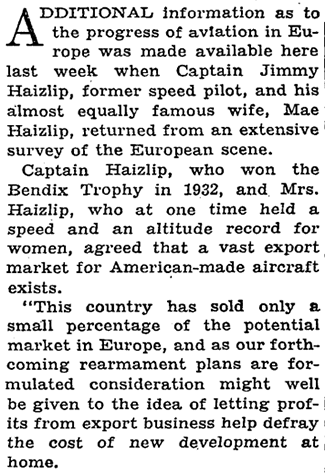 |
May and James together traveled from Antwerp, Belgium to New York City aboard the S.S. Ilsenstein, arriving December 17, 1938. From the "Air Currents" column published in The New York Times of December 25, 1938, we can determine the reason for this voyage, right. Compare the findings of the Haizlips with those of Grand Central Air Terminal pilot Gordon Mounce, who represented Consolidated Aircraft in Europe during the mid-1930s.
They also enjoyed significant national recognition for their flying exploits. The Florence TImes (AL) of January 20, 1934 stated, "Jimmie and Mae Haizlip are to America what the Mollisons are to England, -- our royal couple of the air." According to the article, they were sponsored by the Shell Oil Company to attend a Rotary Club luncheon at Florence on Monday the 22nd. They were greeted at the airport by the Mayor, a judge, the president of the Rotary Club and prominent citizens. Prior to the luncheon, many were taken aloft by the Haizlips in their airplanes.
One of the reasons for the Haizlips appearing in Florence sponsored by Shell was to present them with personal invitations to attend the Pan-American Air Races to be held in New Orleans during Mardi-Gras week in February. The article encouraged as many citizens as possible to show up at the Florence airport on Monday morning at 10:30. The presence of the Haizlips in town was a big deal at the time.
Among other civil activities, in 1934 she judged a model airplane contest, as documented in Flying Magazine, January, 1934, below.
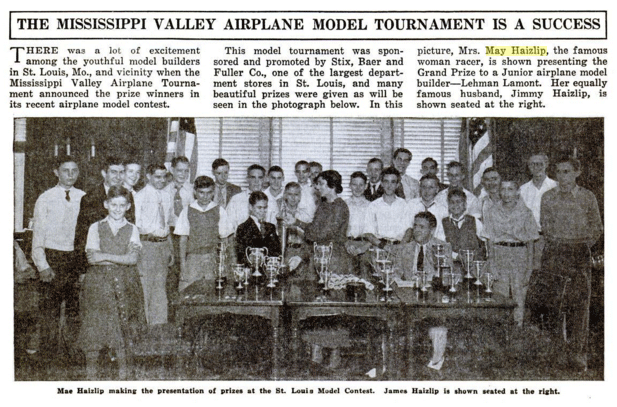 |
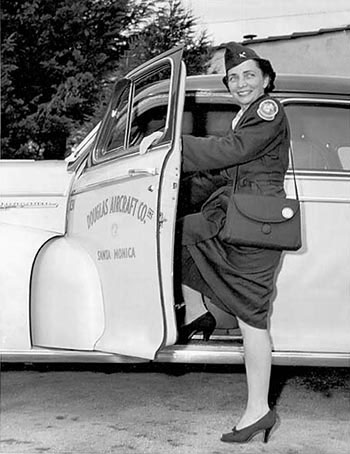 |
 |
The State of Florida Census for 1945 cited James (a major in the Army), age 49, and May, age 40 and a "Housewife," living in Coral Gables. Hays was not living with him, which is not unusual as he would have been 23 years old. This Census identifies both James and May as holding four-year college degrees.
The photograph, left, shows her during WWII. She worked for the Douglas Aircraft Company in Santa Monica, CA. The Nevada State Journal (Reno, NV) of June 13,1943, right, described her job.
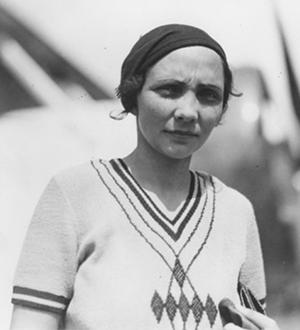 |
I know little about her life from WWII until her passing. At least through 1982 she owned a real estate company (refer to her induction into the Oklahoma Aviation Hall of Fame quoted above).
May Haizlip lived a full life in aviation, participating in and winning some of the premier races during the pinnacle of National Air Races history. She participated in activities to build aviation as a science and occupation through teaching and public relations.
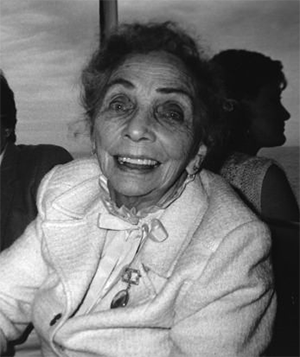 |
She passed away January 30, 1997 at age 92 in Pacific Palisades, CA. She was cremated and the location of her remains is unknown (some indication she was buried at sea). Photograph, above, shows her at the 1932 National Air Races in Cleveland posed in a tennis sweater. May Haizlip has a sizeable Web presence, as well as good coverage by online newspaper and magazine archives. Photograph, right, from SDAM shows her in later life.
Note: Some sources spell her name as Mary or Mae Haizlip. I'll say May is correct, because it appears on her U.S. Census documentation and her U.S. Social Security and death records with or without her middle initial. But it wasn't unusual to find reference made to her by her husband in correspondence as "Mary." Take your pick.
---o0o---
SPONSORED LINKS
THIS PAGE UPLOADED: 05/10/16 REVISED:
